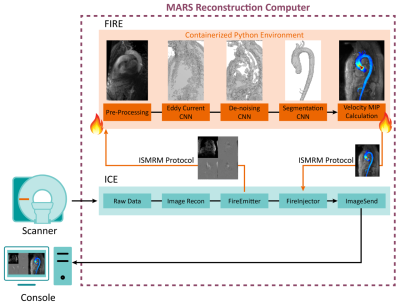Justin Baraboo1, Michael Scott1, Haben Berhane1, Ashitha Pathrose1, Michael Markl1, Ning Jin2, and Kelvin Chow1,2
1Northwestern, Chicago, IL, United States, 2Cardiovascular MR R&D, Siemens, Chicago, IL, United States
1Northwestern, Chicago, IL, United States, 2Cardiovascular MR R&D, Siemens, Chicago, IL, United States
4D Flow MRI suffers from manual off-line post processing. To
address this, we integrated our deep learning tools for automatic 4D Flow
processing within the on scanner reconstruction through Siemen’s Framework for
Image Reconstruction (FIRE) interface, testing on 11 patients and 1 control.

Fig 1. Siemen’s FIRE framework allows for augmentation to Siemen’s image
reconstruction environment (ICE), creating an interface where data can be
requested and sent back into the ICE pipeline via FIRE emitter and injector. Reconstructing
4D-Flow images are sent to a containerized Python environment. A 3D Phase
Contrast MRA is calculated prior to input to turnkey execution of our networks (CNN, outputs above). An aortic MIP cine is calculated from the
velocity data and aortic segmentation and sent back to the ICE pipeline to be
delivered to the console with reconstructed 4D-Flow data.

Fig 4. 4D-Flow with integrated aortic
velocity MIP cine visualization using FIRE in a healthy control. The processing
pipeline included deep learning pre-processing and segmentation with calculation
of an aortic velocity MIP cine. The MIP
cine is displayed on the console alongside the standard reconstruction of phase
and magnitude images. Deep learning processing and segmentation performed
successfully despite artifacts from a metallic spinal implant.